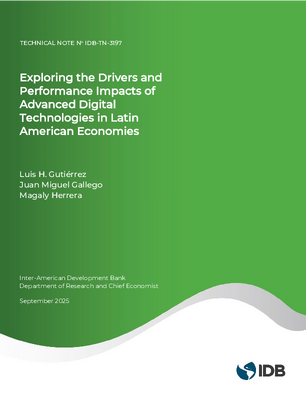Exploring the Drivers and Performance Impacts of Advanced Digital Technologies in Latin American Economies
Date issued
Sep 2025
Subject
Digital Technology;
Small Business;
E-Commerce;
Cloud Computing;
Manufacturing Industry;
Artificial Intelligence;
Productivity;
Labor Force;
Retail
JEL code
L25 - Firm Performance: Size, Diversification, and Scope;
M12 - Personnel Management • Executives; Executive Compensation;
O14 - Industrialization • Manufacturing and Service Industries • Choice of Technology;
O31 - Innovation and Invention: Processes and Incentives;
O33 - Technological Change: Choices and Consequences • Diffusion Processes
Category
Technical Notes
The diffusion of medium and advanced digital information and communication technologies (ICTs)such as e-commerce, websites, cloud computing, and artificial intelligencehas progressed at a rapid pace. However, this diffusion has been uneven across countries, as well as across firms of different ages, sizes, and sectors within countries. In Latin America, this issue is compounded by the lack of firm-level data, which has limited our understanding of how these technologies are being adopted. Using firm-level data provided by the national statistical offices of Chile, Colombia, and Ecuador, we analyze the stylized facts of adoption of cloud computing and artificial intelligence across firm size, age, and sector groups. We examine whether the factors associated with technology adoption in advanced economies also apply in this regional context. Our findings indicate that many of the determinants identified in studies of European and U.S. firms--such as firm size, human capital, and access to complementary resources--are similarly relevant in Latin America. Larger firms, those with higher levels of human capital, and those with access to enabling conditions tend to be earlier and more consistent adopters of digital technologies. Finally, we analyze how the use of cloud computing and AI adoption relate to firm performance. For cloud computing, we find a positive and statistically significant effect across all three economic sectors--manufacturing, retail and wholesale, and services--as well as in all four countries considered. However, for Chilean firms in the manufacturing, retail, and wholesale sectors, the effect is not statistically significant. In the case of AI adoption, Colombian firms experience a positive impact on sales. Nevertheless, this effect loses statistical significance once we implement a two-step procedure that plausibly accounts for endogeneity.
NO


